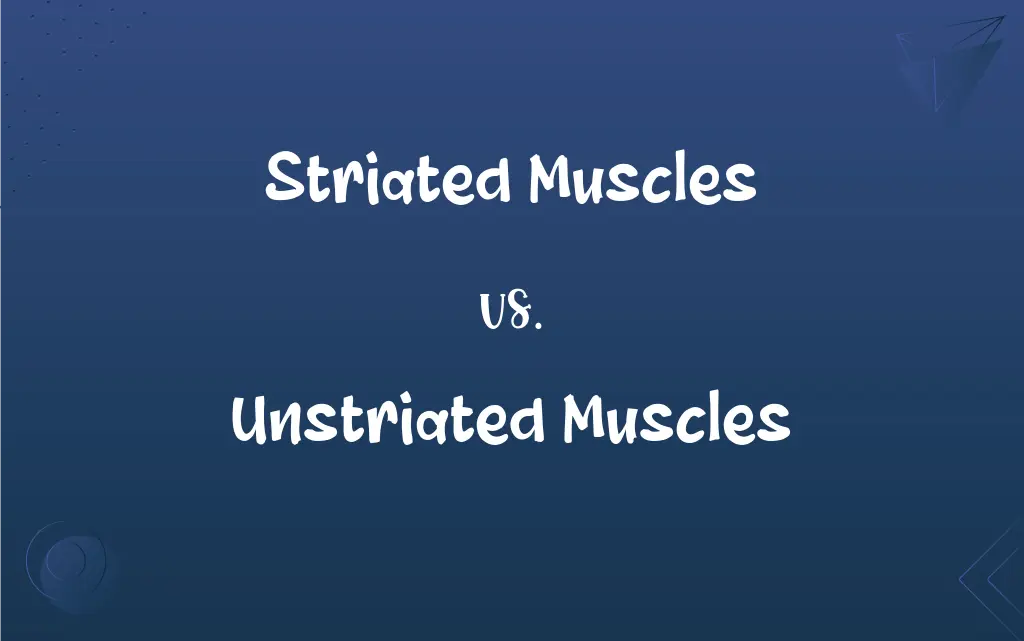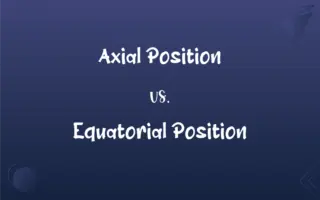Striated Muscles vs. Unstriated Muscles: What's the Difference?
Edited by Aimie Carlson || By Janet White || Published on February 11, 2024
Striated muscles are voluntary, patterned muscles like skeletal and cardiac muscles; unstriated muscles are involuntary, smooth muscles found in internal organs and vessels.

Key Differences
Striated muscles, also known as skeletal muscles, are characterized by their striated appearance under a microscope, due to the orderly arrangement of actin and myosin filaments. This structure is essential for their role in voluntary movements, such as walking or lifting. On the other hand, unstriated muscles, also known as smooth muscles, lack these visible striations. Found in internal organs like the stomach, bladder, and blood vessels, they are responsible for involuntary functions like digestion and blood flow regulation.
The contraction mechanism in striated muscles is fast and forceful, allowing for quick, precise movements. This is facilitated by their highly organized sarcomeres. In contrast, unstriated muscles contract more slowly and less forcefully but can sustain contractions for longer periods. This is suitable for their roles in processes like peristalsis in the gastrointestinal tract.
Striated muscles are under conscious control, meaning they are activated by voluntary signals from the nervous system. This allows for deliberate actions like running or speaking. Unstriated muscles, however, operate under the control of the autonomic nervous system, responding automatically to internal body conditions, without conscious control.
In terms of regeneration and repair, striated muscles have a limited capacity to regenerate after injury, relying primarily on the growth of existing muscle fibers. Unstriated muscles, however, have a greater capacity to regenerate and repair, which is crucial given their continuous, non-stop functioning in vital body systems.
Histologically, striated muscles show alternating light and dark bands, giving them a striped appearance. Each muscle fiber is multinucleated, reflecting their origin from multiple fused cells. Unstriated muscle fibers, in contrast, have a more uniform appearance without distinct bands and are typically uninucleated, with each cell originating independently.
ADVERTISEMENT
Comparison Chart
Appearance
Striated, with visible banding
Smooth, without visible striations
Control
Voluntary (conscious control)
Involuntary (autonomic control)
Contraction Speed
Fast and forceful
Slower and less forceful
Location in Body
Attached to bones, heart
Walls of internal organs, blood vessels
Regeneration and Repair
Limited regeneration capacity
Higher regeneration capacity
ADVERTISEMENT
Striated Muscles and Unstriated Muscles Definitions
Striated Muscles
Striated muscles are voluntary muscles with a banded appearance.
Biceps and triceps are examples of striated muscles used in arm movements.
Unstriated Muscles
Unstriated muscles are involuntary, smooth muscles in internal organs.
The digestive tract's movement is controlled by unstriated muscles.
Striated Muscles
Striated muscles are multinucleated, reflecting their cellular structure.
Repairing a striated muscle injury can be challenging due to its complex structure.
Unstriated Muscles
Unstriated muscles control automatic bodily functions like digestion.
The bladder's contraction is a function of unstriated muscles.
Striated Muscles
Striated muscles are characterized by their organized sarcomeres.
The striated muscles in the legs enable running and jumping.
Unstriated Muscles
Unstriated muscles lack the banded appearance of striated muscles.
Blood vessels are constricted and dilated by unstriated muscle action.
Striated Muscles
Striated muscles include skeletal and cardiac muscles, showing distinct stripes.
The heart's pumping action is driven by striated cardiac muscle.
Unstriated Muscles
Unstriated muscles have a slower contraction rate but sustain longer.
Unstriated muscles in the stomach slowly churn food for digestion.
Striated Muscles
Striated muscles facilitate rapid and precise voluntary movements.
Facial expressions are controlled by small striated muscles.
Unstriated Muscles
Unstriated muscles are typically uninucleated and less regenerative.
Damage to unstriated muscles in organs can impact their function.
FAQs
Are striated muscles consciously controlled?
Yes, striated muscles are under conscious control.
What are unstriated muscles?
Unstriated muscles are involuntary, smooth muscles found in internal organs and vessels.
What is the primary function of unstriated muscles?
They control automatic functions like digestion, blood flow, and organ regulation.
Where are striated muscles found?
They are primarily attached to bones and also include the heart's muscle.
Do unstriated muscles have a high regeneration capacity?
Yes, they have a higher capacity for regeneration and repair.
Where are unstriated muscles located?
They are located in the walls of internal organs like the stomach, intestines, and blood vessels.
What are striated muscles?
Striated muscles are voluntary muscles with a striped appearance, including skeletal and cardiac muscles.
What functions do striated muscles perform?
They are responsible for voluntary movements like walking, speaking, and facial expressions.
Can striated muscles regenerate after injury?
They have limited regeneration capacity, relying on the growth of existing fibers.
Are unstriated muscles under voluntary control?
No, they are controlled by the autonomic nervous system and are not under conscious control.
What causes the striations in striated muscles?
The striations are due to the orderly arrangement of actin and myosin filaments.
How many nuclei do unstriated muscle cells have?
Unstriated muscle cells are typically uninucleated.
What is the speed of contraction for unstriated muscles?
Unstriated muscles contract more slowly and with less force.
How many nuclei do striated muscle cells have?
Striated muscle cells are multinucleated.
Can striated muscles sustain long contractions?
No, they are designed for quick, precise movements rather than sustained contractions.
Do both types of muscles use the same energy sources?
Both use ATP for energy, but their usage and requirements differ based on their function.
Can exercise influence striated muscle structure?
Yes, exercise can enhance the size and efficiency of striated muscles.
Are unstriated muscles involved in digestion?
Yes, they play a key role in the digestive process.
Are diseases affecting striated and unstriated muscles different?
Yes, they are affected by different conditions due to their distinct structures and functions.
How fast do striated muscles contract?
Striated muscles contract quickly and forcefully.
About Author
Written by
Janet WhiteJanet White has been an esteemed writer and blogger for Difference Wiki. Holding a Master's degree in Science and Medical Journalism from the prestigious Boston University, she has consistently demonstrated her expertise and passion for her field. When she's not immersed in her work, Janet relishes her time exercising, delving into a good book, and cherishing moments with friends and family.
Edited by
Aimie CarlsonAimie Carlson, holding a master's degree in English literature, is a fervent English language enthusiast. She lends her writing talents to Difference Wiki, a prominent website that specializes in comparisons, offering readers insightful analyses that both captivate and inform.







































































